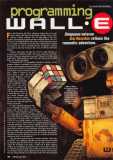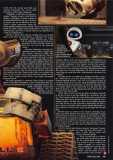For Jim Reardon, the Pixar adventure began four years ago with a phone call from an old friend, Finding Nemo writer-director Andrew Stanton. The two had gone to Cal Arts together and had both scripted episodes of Mighty Mouse: The New Adventures for Ralph Bakshi early in their careers. Reardon stayed in Los Angeles, becoming one of the main creative forces behind The Simpsons (as well as a prolific director of episodes). Stanton went north to the San Francisco Bay Area and Pixar Animation Studios.
"Andrew had gotten the idea for WALL-E while working on Finding Nemo," Reardon recalls. "For years, whenever I saw him, he said, ‘When are you going to come up?' I figured, well, his movie made half a billion dollars, I had better take him up on his offer before he changes his mind!"
So, Reardon left TV's Springfield (though he remains a long-distance Simpsons consultant, reviewing storyboards), moved upstate and joined Pixar as Head of Story on WALL-E. Eventually, he and Stanton would co-write its screenplay. "Andrew wanted to do this movie about a robot, and with very little dialogue," says the soft-spoken Reardon. "I thought that sounded like a great challenge. Sometimes there's too much talking in modern animated movies, especially with the stunt casting. I'm a silent film fan. I saw all the Charlie Chaplins and Buster Keatons in college. And we screened them again for our story staff, for those who hadn't seen them."
It seems especially apparent that two of Chaplin's masterpieces, City Lights and Modern Times, influenced WALL-E. "Yeah," Reardon agrees. "I think City Lights has the best movie ending, especially for a silent film. Our ending isn't quite like that, but it has some of the same spirit. We originally conceived of WALL-E as a silent comedy, and then as we began to work on it, WALL-E became less of a comedy and more of a romantic adventure. But we always thought of WALL-E himself as a kind of Chaplin or Keaton type. We struggled for a while trying to find a story arc for his character. How does he grow? How does he change? He's an innocent. He's not childish, but childlike. How does he become sentient? How does he develop a personality? And the story are for the movie is huge. It's as much as about [his robot love] EVE as it is WALL-E."
[…]

